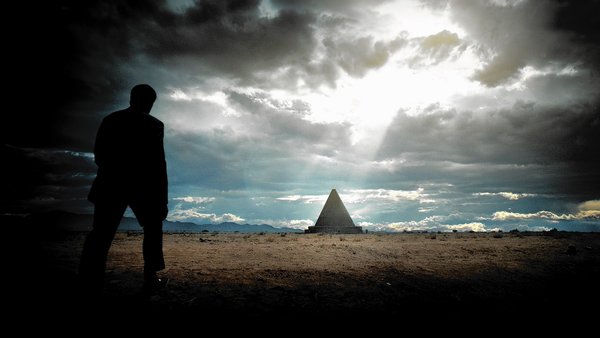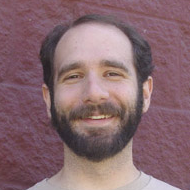Last Sunday's Cosmos took on the related concepts of extinction and climate change, topics I’ve had on my mind since reviewing The Sixth Extinction and interviewing author Elizabeth Kolbert. Neil deGrasse Tyson walks us through many of the great extinctions in history, the ancient forests that gave us the coal that powers our society, and the destruction we’re wreaking by burning fossil fuels. Tyson observed that the dinosaurs never saw the asteroid coming to destroy their world, but we can see a comparable threat. “What’s our excuse?” he asks, for recreating a climate “last seen by the dinosaurs, a climate that will drown our coastal cities, and wreak havoc on the environment and our ability to feed ourselves.”
 Neil deGrasse Tyson approaches the animated Halls of Extinction, including a hall for today's Anthropocene extinctions.
Neil deGrasse Tyson approaches the animated Halls of Extinction, including a hall for today's Anthropocene extinctions.Tyson opened by talking about The Great Dying, which ended the Permian period. It was a cataclysm combining massive global warming and ocean acidification with bacterial blooms that poisoned the skies and water with hydrogen sulfide. Carl Zimmer described the world of the end-Permian as “a truly grotesque place” with purple seas and green skies. Tyson’s graphics team does a great job bringing this world to life, then destroying it. They did that again for the extinction ending the Cretaceous (and the reign of dinosaurs), and again for the ice ages that prevailed until not so long ago.
For each of those worlds, they also recreated the shapes of the continents, and described how Alfred Wegener proposed, and Marie Tharp and Bruce Heezen helped demonstrate, that those continents move over time. “The past is another planet,” Tyson emphasized, and in each of these worlds they did things differently than we do here. But the forces that created those worlds are the same as the ones shaping ours, and we can learn from them.
In the late Permian, it was massive volcanic eruptions that burned vast deposits of coal, emitting catastrophic volumes of carbon dioxide that cooked the skies and turned the seas to acid. In a short stretch, maybe as little as 100,000 years, 90% of life on earth was destroyed. Today, coal deposits are burned to generate electricity, but the carbon dioxide emissions per year could be even greater than they were at the onset of the Great Dying. Scientific assessments like the just-released National Climate Assessment build on our knowledge of past worlds to understand the new world we’re in the process of creating. “The future is a different planet, too,” as Tyson reminds us.
Science takes time, unfortunately. While the basic mechanism of climate change has been understood for over a century, nailing down the details took time, and understanding which actions will address the crisis also takes time. Remaining scientific uncertainty can easily be blown out of proportion and used as an excuse for inaction. The story of continental drift is sometimes misappropriated by climate change deniers and creationists for exactly this purpose, to claim that since scientists wrongly rejected continental drift, we can’t be certain that modern science isn’t wrong. For instance, here’s Discovery Institute shyster Casey Luskin’s response to the Cosmos episode, which focuses on its discussion of Wegener:
Cosmos has done a wonderful job of recalling how old mistaken ideas were overturned–ideas about geocentrism, stellar composition, continental drift, whether lead is dangerous to human health, and more. However, these are all tales from the annals of scientific history. Cosmos presents current scientific thinking as if it were all correct, with everything figured out, never recognizing that today too there are serious questions about dominant scientific ideas. Certainly Tyson never discusses evidence that challenges the prevailing evolutionary view.
Carl Sagan, creator of the original Cosmos series, had a good response to such arguments. He quipped in Broca’s Brain: “The fact that some geniuses were laughed at does not imply that all who are laughed at are geniuses. They laughed at Columbus, they laughed at Fulton, they laughed at the Wright brothers. But they also laughed at Bozo the Clown.”
Indeed, Tyson’s retelling of the tale of continental drift actually explains why Luskin’s discussion of Wegener and the overturning of scientific consensus goes wrong, and how science moves forward. Continental drift was an idea that floated around in scientific circles for centuries, but wasn’t widely accepted until the 1950s, even though Alfred Wegener had laid out a compelling case for it in the 1910s and ’20s. While part of the reason for that delay can be attributed to hard-headed geologists–Tyson reminds us that scientists “aren’t always faithful to the core values of science"–more of the problem lay with the missing pieces. What mechanism would allow continents to move and would account for the way continents and mountain ranges and oceans are arranged?
Similarly, part of the delay in widespread acceptance of Darwinian evolution can be attributed to religious qualms, but much can be attributed to the fact that the method of inheritance Darwin proposed wouldn’t allow natural selection to produce novelty. Not until a better mechanism (Mendelian genetics) could be grafted onto Darwin’s framework did the idea take off. Similarly, the idea of continental drift couldn’t take hold until we understood more about the differences between continental and oceanic crust, and the dynamics of the inner Earth and geology of the deep sea. Yes, geologists of the ‘20s should have been more open to Wegener’s ideas, and Baconian idols did a lot to block widespread acceptance of continental drift, but there were legitimate questions.
In cases like creationism, climate change denial, and other science denials, those missing mechanisms are often the biggest problem. Pseudoscientists have concocted an explanation that seems to explain everything we see, but that could just as easily be tweaked to explain anything else we could imagine seeing. A supernatural creator (or “intelligent designer”) can do anything at all, so is scientifically a useless hypothesis. Climate change deniers’ invocations of “natural cycles” operating without any known physical basis are similarly capable of being adapted to explaining everything, and thus nothing. In the geology of 1910, Wegener’s ideas, lacking mechanism and coming from a meteorologist rather than a geologist, may well have seemed just as malleable, and (as Naomi Oreskes argues) many of his colleagues felt that his approach was unscientific.
Wegener’s response, and that of others who saw value in his views, was not to seek to force the idea into textbooks, or to create his own pseudoscientific journals to tout the idea. They did research, mapping the sea floors to understand the spread of mid-oceanic rifts. They mapped the edges of tectonic plates, and deepened our knowledge of how mountains rise up and why earthquakes happen. The scientific community came to accept the radical new idea once a body of research coalesced to explain how continents really could move apart and together.
What Tyson understands, and Luskin doesn’t, is what Isaac Asimov called “the relativity of wrong.” Answering a letter advancing a view like Luskin’s, Asimov quipped: “John, when people thought the earth was flat, they were wrong. When people thought the earth was spherical, they were wrong. But if you think that thinking the earth is spherical is just as wrong as thinking the earth is flat, then your view is wronger than both of them put together.” Luskin wants to believe that because today’s science could be wrong, therefore “intelligent design” creationism might be right. But creationism is wrong to a degree that today’s science couldn’t be. The future is a different planet, as was the past, but we don’t start over from scratch. Today’s science is built on the foundations laid by our predecessors, and when new scientific theories replace old ones, it is because they explain and predict everything the old science did, and more. Where does that leave the theory-less, mechanism-less muddle that is “intelligent design”? On a whole ’nother planet.

